This is a difficult season for RB Leipzig, who lost the head coach Julian Nagelsmann with key players leaving during the summer. Fresh faces such as Jesse Marsch from RB Salzburg, Achim Beierlorzer returning from Mainz 05, with new players including André Silva, Joško Gvardiol, Mohamed Simakan, and Benjamin Henrichs joined the team. However, things did not go according to plan as they never looked like a side that could challenge the second place in the Bundesliga, while they were knocked out very early in the UEFA Champions League group, after losing to Manchester City and PSG.
Therefore, the higher-level authority of Leipzig decided to react by parting ways with Marsch. Soon, they appointed Domenico Tedesco as the new head coach and handed him a contract until June 2023. In Tedesco’s first three games, he obtained 1W1D1L, which was not particularly impressive, but there were interesting tactics behind it. Compared to Marsch who did not constrain his approach by formations, Tedesco was relatively consistent on a 3-5-2 formation, which also achieved good performance under Marsch. This tactical analysis gives an early look at how Tedesco would transmit his philosophy and ideas into the team based on the first three games before the winter break.
3-2 or 3-1?
According to media reports, some said the players were not comfortable with Marsch’s very vertical approach. In the offensive organization, they lost a bit of positional dynamics, rotations, and rhythm that were demonstrated under Nagelsmann. What Tedesco added to the team was a structure to give Leipzig more control in the match, compared to the rather direct approach of Marsch that led to more transitions in the final third.
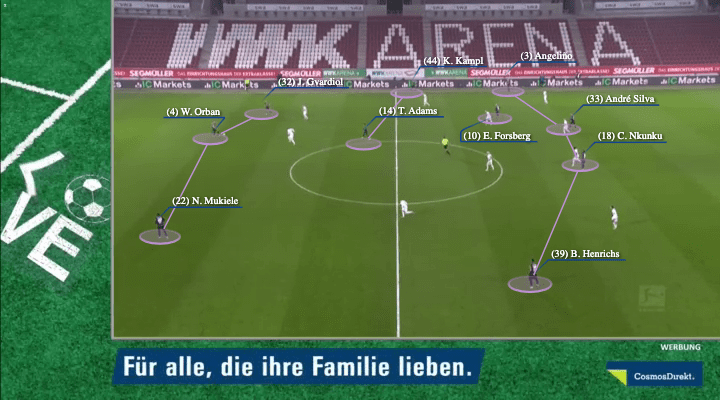
In the first two games, Tedesco played his team in a 3-4-1-2, which means there were two 6s in the second line. Against Armenia Bielefeld, he opted for a more aggressive approach by playing a 3-1 shape in the construction phases, pushing Tyler Adams to higher spaces with Dominik Szoboszlai. Both were tactically important as they provided the solutions to encounter different opposition shapes, and thus, created the progressive methods to advance the attack.
We give a big picture of the positions of players in the first image. Interpret this as a 3-2-1-4 as the wing-backs could be high, depending on what Tedesco was expecting. Sometimes Angeliño would be providing the offensive height on the left side, pinning the opposition wide defender, and rarely dropped back to help. Then, Leipzig vacated the left-sided spaces in the central third to organize the attack.
Intriguingly, as suggested by Kevin Kampl and Adams’ positioning above, the 6s might not be disciplined to stay centrally. Instead, one of the 6s could, usually Kampl, would operate wider and Leipzig were flexible to shift between a 3-1 and a 3-2 shape.
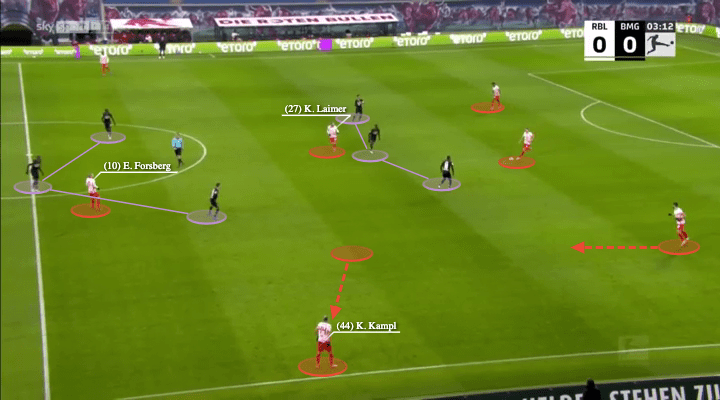
Tedesco wanted his back three to invite the opposition first line to the centre, which then would open other spaces on the pitch to attack. In the above situation, Borussia Mönchengladbach played with a 4-diamond-2 initially but it became a narrow 4-1-2-3 when they matched the back three. It was a 4v3 numerical advantage as Konrad Laimer was operating behind the first line, pulling the striker down to give Willi Orbán spaces to pass.
The 10 of Leipzig’s 3-4-1-2 or 3-3-2-2 had an important role to manipulate the second line. With his off-ball movements behind the opposition midfielders, he should drag that midfielder down to open spaces for his teammates. So, in this instance, the Mönchengladbach wide midfielder was late to press Kampl as Emil Forsberg appeared in the left half-spaces, he must be covered before jumping out to press Kampl, or else Leipzig could go vertically in the half-spaces.
Note that it was also a 2v1 overload on Jonas Hofmann if the first pass broke the first line, this numerical superiority was another concept we would dig into in the next example.
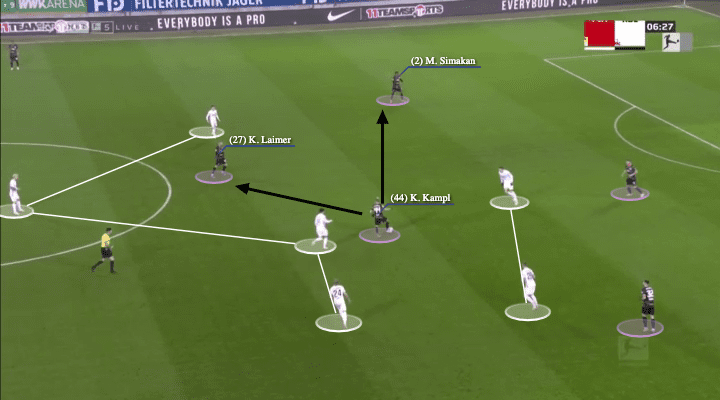
Leipzig wanted to have the 2v1 overload on the weaker side, and use that “+1” advantage to move the ball forward. Let’s see how they did that against Augsburg’s 4-4-2. The opposition was forced to change into a 4-1-3-2 as Forsberg was behind the second line, when that happened, the linkage between the two opposition midfielders was cut and they could not cover each other.
Therefore, it was a great advantage when Kampl received in the centre. Firstly, Simakan freed himself because of the 3v2 advantage in the first line, two Augsburg strikers were unable to cover three centre-backs. As Laimer was around to help, it became a 2v1 overload on the right side against the opposition left-winger, the free player became obvious to search for and Leipzig could play out from the back.
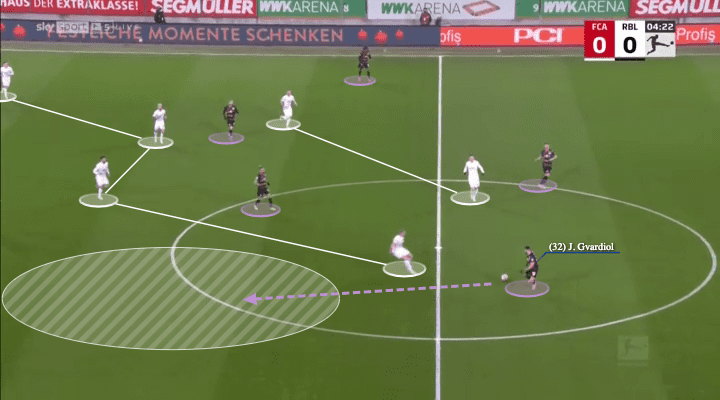
The Leipzig wing-backs were staying quite high in the first two games to push the last line down, so they could stretch the block vertically and creating more spaces for the players in the construction phases. Particularly, they liked to go out from the left side as Gvardiol was a very talented progressor, who had good passing skills and the physical strength to carry the ball forward.
In this example against Augsburg, who adapted into an asymmetrical 4-4-2 or a 4-3-3 shape, Gvardiol demonstrated his ability to bring the ball forward. It was still a 3-2 structure in the middle as Laimer and Kampl were fixing the opposition midfielders in the centre. This was important as now the Croatian defender had a 1v1 versus the opposition right-winger, Gvardiol had enough quality to beat the opponent, he should go to the white spaces where were created by the position of Leipzig 6s. Another prerequisite to create this circumstance was the 3v2 in the first line, which was explained above with the use of three centre-backs.
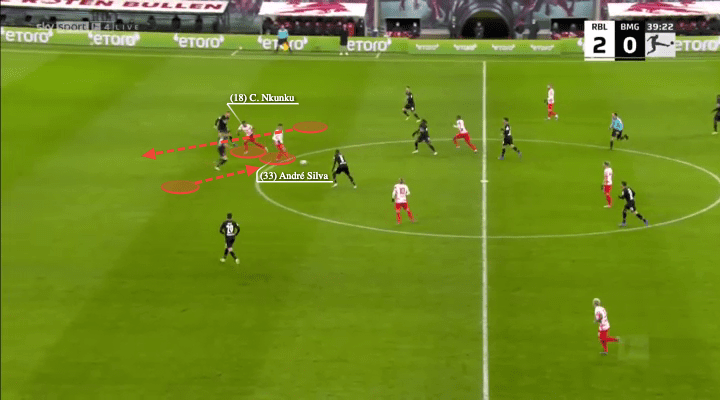
Apart from the 3-2 or 3-1 structure, Leipzig also improved the coordination of two strikers. Under Marsch, they also searched for the attacking depths frequently with the runs of Silva, but even in a two-striker system, the front line lacked chemistry and they could not maximize the threat of this approach (we explained their difficulties in this analysis). Tedesco just added little elements to allow his strikers to create a better dynamic in the attack.
In the second phase, Silva now showed up behind the opposition second line more to receive the ball at feet, but this was never an individual movement. Two strikers versus two centre-backs was a 2v2 situation, which could result in isolations and separations. When Silva dropped, his partner, mostly Christopher Nkunku, must be facing the opposition goal and made a run behind. This reversed movement between the two strikers would pose a question on the centre-backs, to follow which guy? They must decide as the Leipzig strikers were going to a reversed direction, and they must be aware of Nkunku’s pace and 1v1 ability as well.
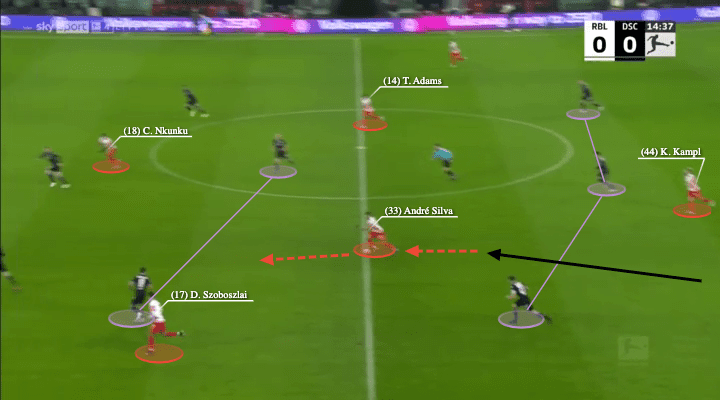
In addition, the 10s of Leipzig played an important role to manipulate oppositions in the midfield in a 3-1-2-4 or 3-3-2-2. If they had a 3-1 structure in deeper spaces, such as in this situation against Arminia Bielefeld’s 4-2-3-1, the Leipzig 3-1 dragged the front four high to open spaces between the opposition 3-1 and 2. Also, they were playing with deeper wing-backs to stretch the 3 of the 4-2-3-1, so they could break the line in the left half-space to connect Silva. Again, you could see Nkunku’s body angle and behaviours, that was the coordination explained in the previous example.
In that positional structure, the most important was to use the two high 10s to stretch the opposition midfielders, so Silva had the space to turn. Look at Szoboszlai and Adams’ above, their positionings served this well.
High pressing & blocks
Regardless the choice of the coach, there was one thing in Leipzig’s football that was inarguable: pressing. Against the ball was the core identity of this club since Ralf Rangnick implemented the style, and his successors, including Ralph Hasenhüttl, Nagelsmann, Marsch, all valued this aspect of the game. Therefore, even the Schalke 04 of Tedesco only ranked 7th in terms of PPDA in 2017/18, and ranked 10th in 2018/19, his Leipzig must be more proactive without the ball and we saw some interesting pressing in these games.
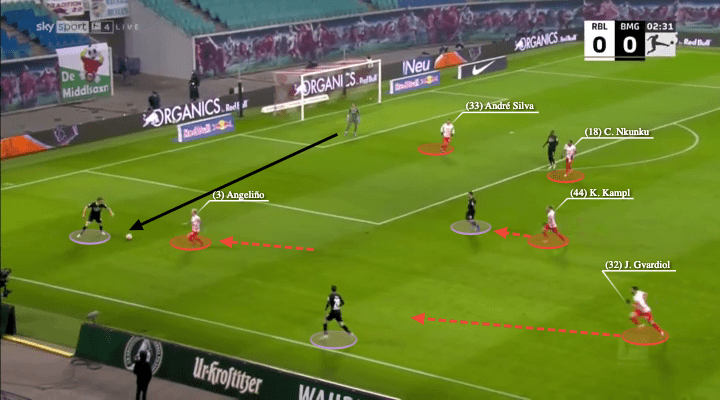
Both Marsch and Tedesco pressed high with a 3-5-2, using the likes of lateral passes, backward passes, passes to the outside defender as the triggers, but Tedesco’s approach was better, and they constrained the build-up of Mönchengladbach to a large extent. The difference was the compactness.
Under Marsch, the block of Leipzig was loose as the far side player was not moving into the centre enough to stay compact, that’s why the opponents had more time and space to look for a passing option and get out. Also, the players were not close enough, they could not support and cover each other. Comparatively, Tedesco’s Leipzig pressed in a different shape to make the shape more compact.
As shown in the above image, you could interpret the first line as a 1-1 instead of two strikers staying in the same horizontal chain. Silva was usually the man higher while Nkunku should cover the 6 under his shadow. Intriguingly, the wing-back, mostly Angeliño went very high to press the centre-back, this was a bold approach as that would leave the wide Mönchengladbach defender unmarked. But the situation was also well-planned as Tedesco instructed the wide centre-back to join the press high as well, with the rest of the backline shifting. Also, the 6s of Leipzig could come up and close the 8s of the opponent in the high press. They kept a man around every short option of the centre-back, and more importantly, the block was compact as they were only defending on one flank.
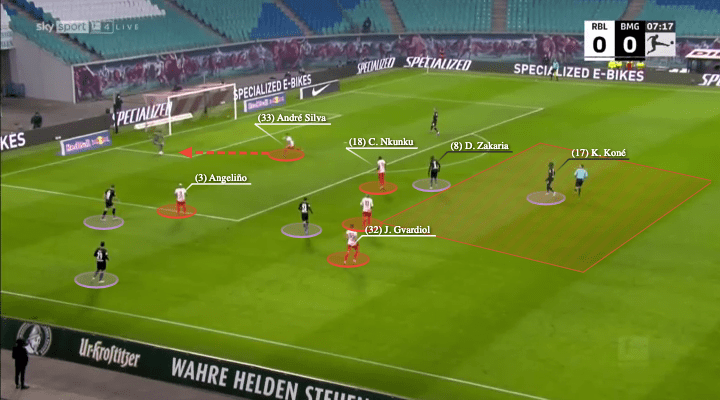
The above image was another instance of the Leipzig high press. Silva was usually the player who went all the way to press the goalkeeper. This was an important tactical concept of Tedesco since his Schalke 04 tenure. Instead of being merely high in a block, he wanted his players to close down the paths of the oppositions by coming from a specific direction. For example, Silva went from Yan Sommer’s left side to force him go right, where Leipzig had players waiting for the pass.
The next step of Leipzig’s pressing was to close the red spaces. They would need better control of spacing and aerial performance to deal with longer passes of the opponents. There were many ways to solve, such as applying the press to force a lower quality out-ball, or developing players’ consciousness, agility, physicality, and timing to turn and close that space when the opponents chipped the ball forward.
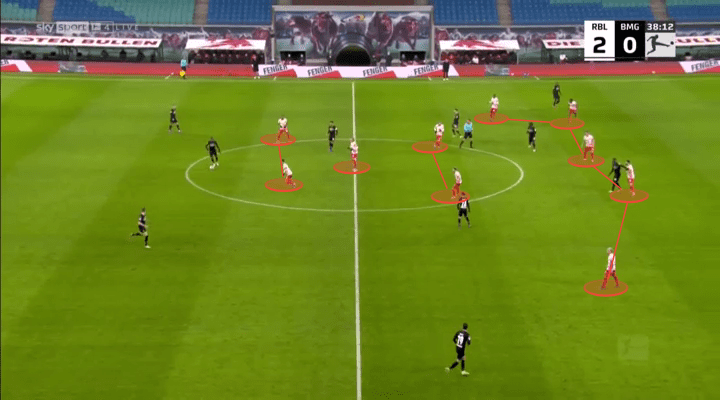
In a midblock, Leipzig spent many efforts to defend the centre with their 5-2-1-2 or 5-1-2-2 shape. For example, in this situation against Mönchengladbach, you could see the wing-backs were very narrow or even closing the half-spaces, they added numbers centrally. And the midfield positionings were pivotal too as they were defending spaces, which means they should not orient themselves towards an opposition even the Mönchengladbach 8s were stretching them in the half-spaces.
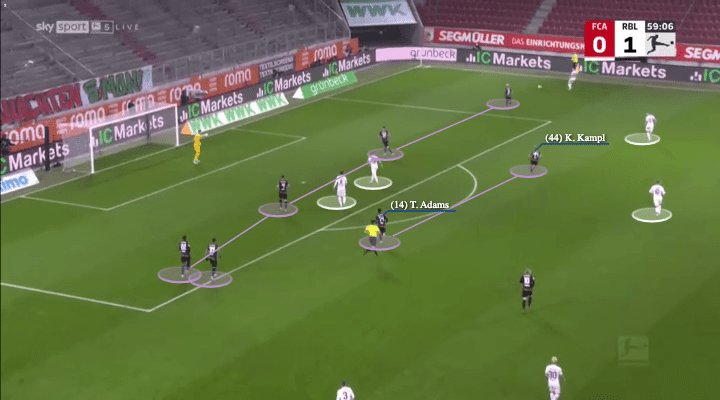
Structurally, the 5-2-1-2 might be a small concern when the 6s were dragged away by the oppositions. Since they tended to keep a 1-2 shape or at least two strikers in the rest offence, the protection of spaces in front of the last line was not enough. Here, they conceded a long shot at the edge of the box as Kampl and Adams were apart, it was a 1v2 on the right side.
Conclusion
This was not a completed Tedesco team as he only had limited time after his appointment. Hopefully, with the winter break, there was time to rest, and injured players such as Forsberg and Yussuf Poulsen could return soon to provide competitions. The squad was very young and sometimes they were not strong enough mentally, being fragile at times. The more experienced players, such as Silva, Lukas Klostermann, and Forsberg, should take the responsibility to lead the squad and help the young players. They could still challenge the UEFA Europa League and top-four in Bundesliga if the consistent level was there, we will also see more from Tedesco in 2022 too!





Comments